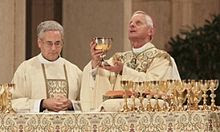O God, eternal shepherd, who govern your flock with unfailing care,
grant in your boundless fatherly love a pastor for your Church
who will please you by his holiness and to us show watchful care.
Through our Lord Jesus Christ, your Son,
who lives and reigns with you in the unity of the Holy Spirit,
one God, for ever and ever.
Amen.
Catholic News ServiceVATICAN CITY (CNS) -- The group of cardinals preparing to enter a conclave to elect a new pope is slightly older -- by four months -- than the group that elected 78-year-old Cardinal Joseph Ratzinger in 2005.
Pope Benedict XVI, now 85, said his age and diminishing energy prompted him to resign for the good of the church, so some cardinals and many commentators expect attention to turn to younger members of the College of Cardinals.
Only cardinals under the age of 80 when the papacy becomes vacant can enter the conclave in the Sistine Chapel to elect a new pope. The cardinal-electors do not have to choose one of their own, but they usually do.
As of Feb. 28, the average age of the 117 eligible cardinal-electors was 71 years, 11 months. In 2005, there also were 117 cardinal-electors (although two did not participate because of illness) and their average age was 71 years, seven months.
The cardinals who elected 58-year-old Cardinal Karol Wojtyla -- Blessed John Paul II -- in 1978 had an average age of 67.
Of the cardinals eligible to elect a successor to Pope Benedict -- those under 80 Feb. 28 -- only five were in their 50s. Thirty-eight cardinals were in their 60s; 74 were in their 70s.
The oldest member of the conclave was expected to be Cardinal Walter Kasper. He was 79 when the Holy See became vacant Feb. 28, but was turning 80 March 5.
The youngest cardinal in the conclave was expected to be 53-year-old Indian Cardinal Baselios Cleemis Thottunkal, major archbishop of the Syro-Malankara Catholic Church. Three other leaders of Eastern Catholic churches also were eligible to join the conclave.
Almost 43 percent of the cardinal-electors were created cardinals by Blessed John Paul and participated in the election of Pope Benedict almost eight years ago. The remaining 57 percent of the voters were named by Pope Benedict.
In the aftermath of the "VatiLeaks" scandal and amid loud cries for a reform of the Roman Curia, 35 percent of the cardinal-electors either work in the curia or have retired from posts at the Vatican.
Only 24 percent of the cardinals in the conclave that elected Pope Benedict were curia members or retirees.
Most of the cardinal-electors are heads of archdioceses around the world.
The 117 come from 50 countries -- fairly close to the 53 countries represented in the 2005 conclave.
The European dominance in the College of Cardinals is slightly stronger than it was eight years ago. Today, 52 percent of the cardinal-electors are European; in the last conclave, 49.5 percent were European.
There are 19 Latin American cardinal-electors, about 16 percent of the total; 14 from the U.S. and Canada, or about 12 percent; and 11 each from Africa and Asia, representing about 9 percent for each continent. Australia and the South Pacific -- "Oceania" in Vatican parlance -- have only one elector, Australian Cardinal George Pell of Sydney.
In the country-by-country breakdown, Italy is significantly stronger than it was eight years ago. Today the country has 28 voting-age cardinals, eight more than in 2005 and two more than in 1978.
Italians now represent almost 24 percent of the conclave voters, compared to 23 percent in 1978; in the conclaves of 1963 and 1958, the Italians made up more than 30 percent of the total number of voters.
The United States has 11 voters, as it did eight years ago; Germany has six; Spain, Brazil and India each have five. France and Poland each have four electors and Mexico and Canada each have three.
Among the voting-age cardinals, there are 19 members of religious orders, or 16 percent of the total, and they include four Salesians, three Franciscans and two Jesuits.
-- Of the 117 Voting Cardinals, 67 were named by Pope Benedict XVI. The remaining 50 were named by Pope John Paul II.
-- Of the living Cardinals, only 6 were Council Fathers at the Second Vatican Council (Cardinals Angelini, Arinze, Canestri, Delly, Fernandes de Araújo, and Lourdusamy). All of them are over 80 and thus will not be in the Conclave.
-- Of the Cardinals alive today, 99 participated as Electors in the 2005 Conclave. Of those, 49 are now over 80 and thus will not be in the new Conclave. (Pope Benedict XVI was also an Elector in 2005.)
The cardinals are listed in various formats (voters, non-voters, by rank, etc.) and the lists can be sorted according to each of the terms included (for example, birth date, name, etc).
Some cardinals pictured here: Cardinal Raymond Leo Burke (Perfect of the Apostolic Signatura), Cardinal Roger Mahony (Archbishop-Emeritus of Los Angeles), Cardinal Daniel DiNardo (Archbishop of Galvaston-Houston), Cardinal Angelo Sodano (Dean of the Collage of Cardinals), Cardinal Timothy Dolan (Archbishop of New York), Cardinal Sean O'Malley (Archbishop of Boston), Cardinal Francis Arinze (Perfect-Emeritus of the Congregation of Divine Worship and Discipline of the Sacraments), Cardinal Tarcisio Bertone (Vatican City Secratery of State), Cardinal Donald Wuerl (Archbishop of Washington D.C.)











No comments:
Post a Comment
Only Positive, Appropriate Comments Please! -Joseph